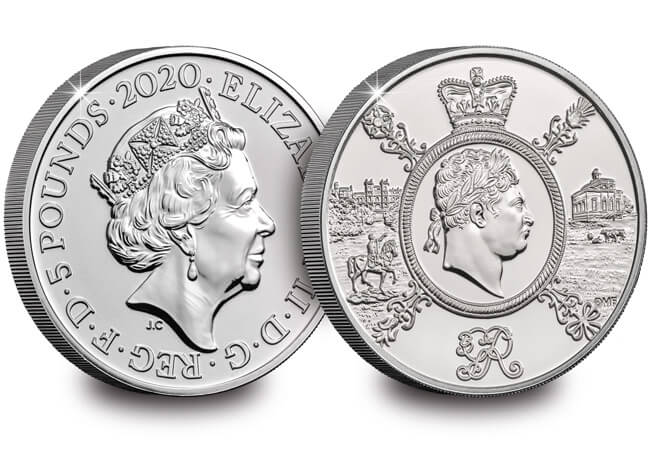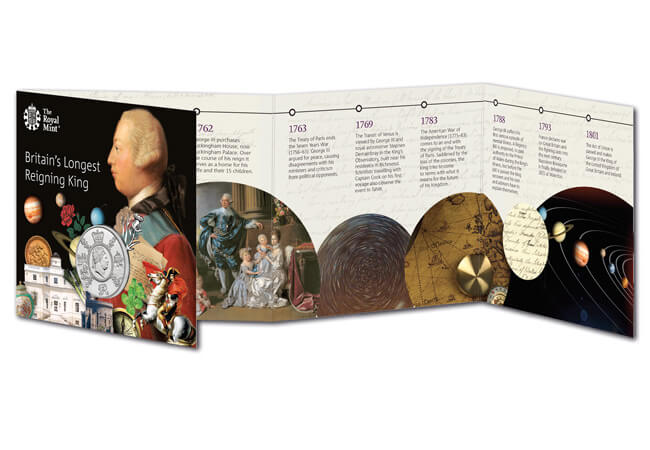Posts Tagged ‘King George III EIC Sovereign Collection’
Celebrating the most iconic coins of King George III’s reign
On 29th January 2020 we marked the milestone 200th anniversary of the end of King George III’s reign. And whilst some will remember him as the ‘Mad King’, there is no denying the coins issued during his reign are some of the most iconic to have ever graced the pockets of the British public.
To celebrate his legacy some of the world’s most renowned Mints have issued some remarkable coin issues.
I’ve picked out some of my favourite designs to share with you today so you, too, can have the joy of discovering the most beautiful coins issued during King George III’s rule.
2020 UK King George III £5 BU £5
In 2020, to mark the 200th anniversary of King George III’s death, The Royal Mint issued this £5 coin.
Struck to a Brilliant Uncirculated finish, this coin features a design by Dominique Evans which explores the multifaceted nature of Britain’s longest reigning king. The design incorporates an effigy of the king alongside the King’s Observatory and Windsor Castle.
King George III’s impressive 59-year reign was memorable for multiple military conflicts, including the end of the American War of Independence and the defeat of Napoleon in the Battle of Waterloo. He oversaw great change in Britain as we emerged as a world power, and was even the first monarch to appear on the modern Sovereign!
I’m sure you’ll agree that this is a stunning issue. Do you have this coin in your collection? Let us know in the comments below.
St George and the Dragon
Designed by renowned engraver Benedetto Pistrucci, the St George and the Dragon design is probably one of the most instantly recognisable motifs in numismatic history. The design first appeared on the modern Sovereign in 1817, when it was struck to replace the gold Guinea following the Great Recoinage Act of 1816, and it still appears on today’s Sovereigns. This made King George III the first monarch to appear on the modern Sovereign, so it’s only fitting really that he is commemorated on a new range of Sovereign coins.
Pistrucci’s iconic design also appeared on King George III’s 1818 Crown, the first type of Crown or Five Shillings to be issued in his reign. This Crown was the first ‘new’ Crown coinage to be struck, and significantly only 155,000 were ever minted – making it highly sought-after amongst collectors today.
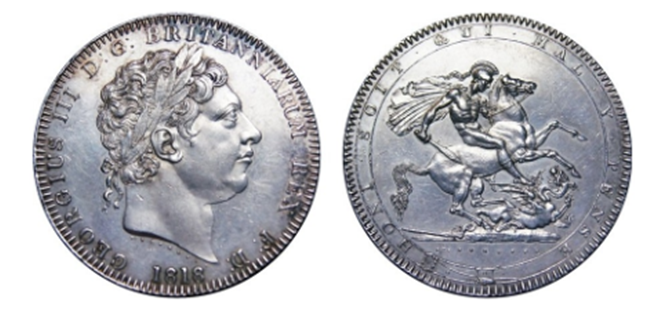
(Image courtesy of JN Coins, http://www.jncoins.co.uk/Shop/milled-crowns/702-george-iii-silver-crown-1818-lix.html)
The East India Company have struck a beautiful interpretation of this timeless design on the most prestigious Sovereign denomination – the Five Sovereign. The spectacular scene is framed by the Latin motto “hoit soit que mal y pense”, which translates to “shame on him who thinks evil of it” – the motto of the British chivalric Order of the Garter.
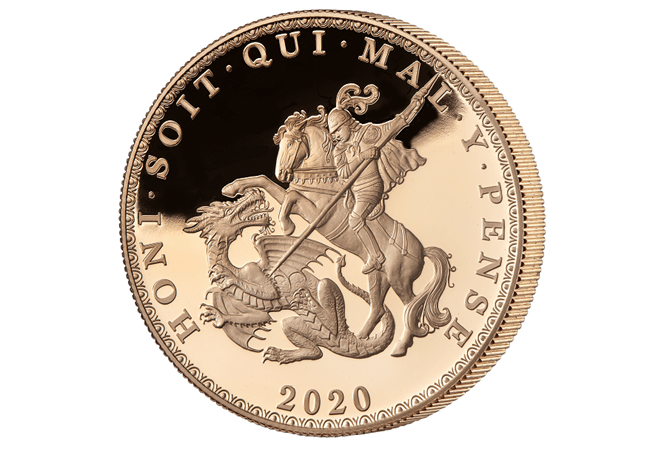
‘Counter Stamped’ Spanish Dollar
The cost of the French Revolutionary Wars, combined with the threat of invasion on the Welsh and Irish coasts, took its toll on the Bank of England resulting in members of the public demanding to withdraw large sums of cash. The result was a currency crisis, as the panicked public depleted the coin and bullion reserves of the Bank of England.
One thing was clear, a solution to the gold and silver coin shortage had to be found, and quickly. At the time most of the Bank’s reserves were held in the most popular coin of the time – Spanish Dollars. To fix the currency crisis King George III authorised the counter stamping of these Spanish Dollars with a ‘puncheon’ of the King’s head as part of the hallmarking. These modified dollars were released rapidly into the market, allaying the currency crisis.
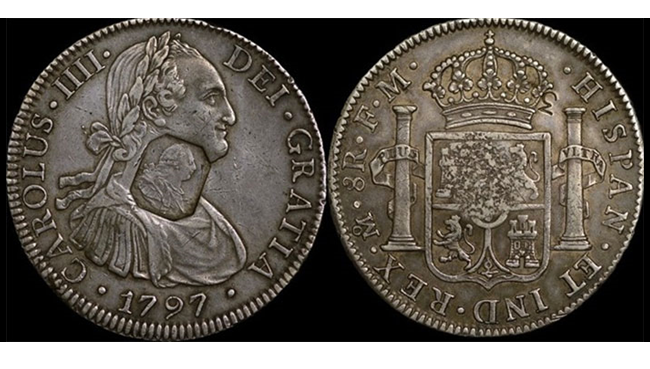
(Image courtesy of coinweek.com, https://coinweek.com/dealers-companies/ma-shops/coinweek-sponsor-amazing-uk-coins-on-ma-shops/)
In tribute to this iconic coin, the East India Company has replicated the design on a Double Sovereign piece. The reverse features an effigy of King Charles III of Spain inset with the effigy of King George III to represent the same process as the original Spanish Dollar coins.
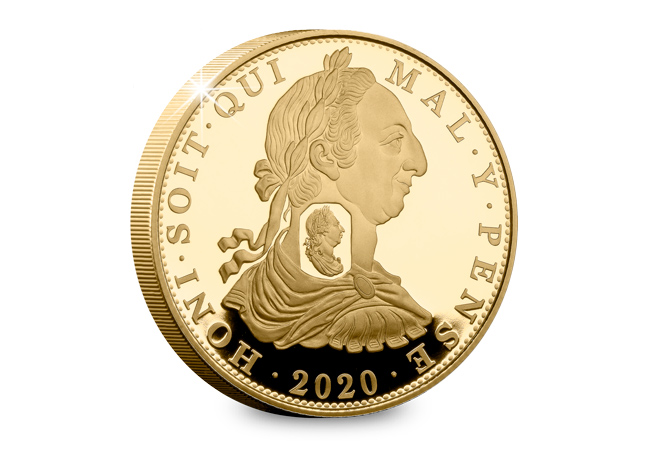
Spade Guinea
Under King George III’s reign Britain witnessed the Great Recoinage Act of 1816, following which the favoured gold coin of the time, the Guinea, was replaced by the Sovereign. This was a huge moment for Britain in terms of its currency as the Guinea had become the very foundation of the British Empire’s growth during the late 17th and 18th centuries. Had the Guinea remained in use it would have been circulating at the time of Wellington’s victory at Waterloo!
In its heyday several different motifs featured on Guineas, but none is as famous as the Spade Guinea. Nicknamed because of the spade-like shield on its reverse, this design featured on the last ever circulating Guinea during King George III’s reign.
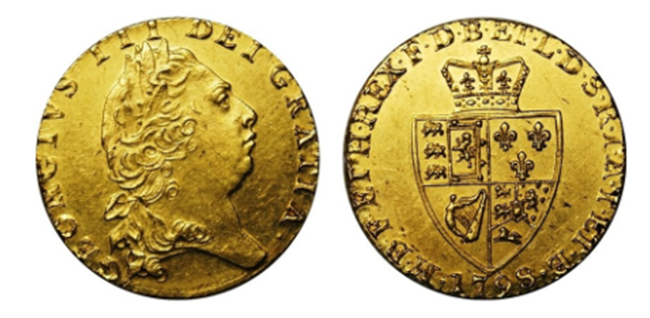
(Image courtesy of JN Coins, http://www.jncoins.co.uk/Shop/milled-gold/118-george-iii-spade-guinea-1798.html)
In fact, this is the only Guinea to feature this distinctive reverse design, and the Half Guinea issued in the same era is the only Half Guinea to also feature it. This makes the Spade Guinea one of a kind. It is this fact which makes the coin fascinating to collectors and historians alike.
Although the Guinea is no longer in circulation you may still come across its name from time to time in classic horse racing. The longstanding tradition of livestock being traded in Guinea values still exists in some auction houses and horse racing organisations because the name ‘Guinea’ is so intrinsically linked with the ‘sport of kings’.
And now this iconic design has been faithfully replicated on a Sovereign, issued by the East India Company. It represents England, Scotland, France and Ireland, as well as the German possessions of the Hanoverian dynasty.
Secure the 2020 UK King George III £5 BU Pack
Available to own in official bespoke Royal Mint presentation packing, the 2020 UK King George III £5 coin has been struck to a superior Brilliant Uncirculated quality.
Secure this bespoke presentation for your collection for just £13.00 (+p&p) by clicking here >>

